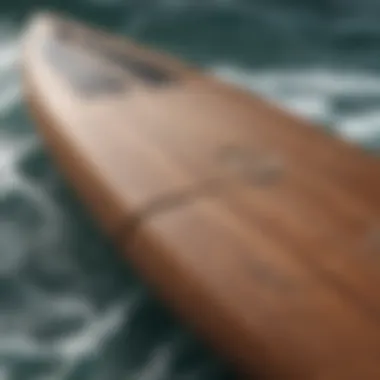Understanding Skipper Surfboards: Design and Impact


Intro
Diving into the world of skipper surfboards opens up a realm rich with history, craftsmanship, and connection to the waters. Skipper surfboards, known primarily for their unique shape and design features, have captivated both amateurs and seasoned surfers. Understanding these boards isn’t just about their physical attributes but also about appreciating the culture they represent within the surfing community.
From the type of materials used to the intricacies of performance characteristics, every element plays a role in how they ride the waves. These boards are often seen as an extension of the surfer themselves, merging technology and artistry in one finely crafted piece.
In this exploration, we will uncover not just the technical specifications that define skipper surfboards but also their evolution through time, addressing how they’ve adapted alongside changes in surfing styles and environmental considerations. This analysis aims to enrich your knowledge, whether you’re just starting out or looking to refine your technique.
Through the lens of design, usability, and cultural relevance, let’s embark on an informative journey into the heart of skipper surfboards.
Foreword to Skipper Surfboards
Surfing is not just a sport; it’s a lifestyle, a culture, and for many, a sanctuary. In this expansive world of waves and boards, Skipper surfboards hold a unique place, merging tradition with modernity. This section unpacks the vital foundations of understanding Skipper surfboards, setting the stage for what follows in this deep dive.
Not just any board, Skipper surfboards are designed with precision, providing both performance and style. Recognizing their importance means acknowledging the nuanced design elements that make them appealing to surfers ranging from beginners to experts. The material choices, variations in shape, and artisanal craftsmanship all come together to create a board that isn’t just functional, but also expressive of the surfer's identity.
Defining Skipper Surfboards
So what exactly are Skipper surfboards? At their essence, they are crafted products that represent the intersection of aesthetics and performance. Characterized by streamlined shapes and distinct outlines, these boards catch the eye while ensuring optimal wave riding experiences. The term ‘Skipper’ evokes both a nod to navigation—pointing toward the underlying goal of riding waves—and to the skilled craftsmanship that brings these boards to life.
Usually, Skipper surfboards are made for any conditions, whether one is just dipping their toes into small surf or tackling bigger waves like a pro. The various models in the Skipper range cater to multiple surfing styles, from paddle surfers to shortboard enthusiasts.
What sets these boards apart is their unique shapes and flexible materials; they offer a combination of agility and stability unmatched by many mainstream brands. This enhances riders' experiences, allowing them to express their individual surfing styles rather than just conforming to standardized options.
Historical Context
To fully appreciate Skipper surfboards, it’s essential to glance back at their historical context. The evolution of surfboards as a whole mirrors technological advancements and cultural shifts within the surfing community. Surfing was once confined to a select few in Hawaii, with wooden boards that gods and kings used, but it quickly morphed into a global mainstay.
The arrival of Skipper boards coincided with a growing desire among surfers to elevate their skills. As methods of board construction progressed from solid wood to lighter materials like fiberglass in the mid-20th century, the shape of surfing changed dramatically. Each decade brought fresh designs, influenced by shifts in styles and the demands of riders.
One notable moment in the Skipper surfboard saga came when designers began experimenting with the balance of buoyancy and maneuverability. These shifts were not just practical—for skimming across waves more effectively—but also creative, propelling innovation in surfboard aesthetics.
As we explore further into the evolution and design of Skipper surfboards, keep in mind that every twist and turn in their journey has led to the boards we see today: visually stunning, high-performing, and deeply embedded in surf culture.
Design Elements of Skipper Surfboards
When exploring the world of Skipper surfboards, the design elements play a pivotal role in determining their performance and suitability for different surfers. The nuances of a surfboard’s construction can greatly influence how well it rides the waves. Each skateboard, a carefully crafted piece, offers surfers a unique experience tailored to their preferences and skill levels. Therefore, understanding these design elements is crucial for both novices and seasoned surfers alike.
Materials Used
Fiberglass
Fiberglass is widely recognized in surfboard manufacturing, and it holds a crucial position due to its weight-to-strength ratio. One of its defining characteristics is its ability to provide rigidity without excessive heft, making it ideal for those who value speed and agility.
This material is often chosen for its resistance to warping and its longevity, which is essential for surfers who engage in regular water activities. However, a downside is its tendency to shatter upon impact rather than dent, leading to more significant repairs. Surfers keen on durability find fiberglass boards often fit their needs well.
Epoxy
Epoxy surfboards have gained traction among surfers due to their unique properties. The key characteristic of epoxy is its lightweight nature, which allows for enhanced buoyancy and facilitates faster paddling. This can be particularly beneficial for those looking to catch waves effortlessly.
Moreover, epoxy boards are noted for their environmental benefits, often manufactured using less harmful materials compared to traditional boards. On the flip side, epoxy surfboards can be less responsive in tight maneuvers due to their flexibility. Still, they attract surfers aiming for a balance between durability and performance.
Wood
Wood surfboards reflect a growing trend toward craftsmanship and traditional techniques. The key advantage here is the natural beauty and warmth of wood, which some surfers find aesthetically pleasing. Furthermore, wood boards can offer a unique riding experience, often providing additional buoyancy that benefits novice surfers learning to balance.
However, they come with their own set of considerations. Wooden surfboards can be heavier compared to fiberglass or epoxy options, which might impact speed and maneuverability. This may lead some more advanced surfers to shy away from wood in favor of lighter alternatives. Still, for those drawn to the craftsmanship, wood boards have their own allure.
Sustainable Alternatives


With increasing awareness around environmental concerns, sustainable alternatives in surfboard production are becoming more mainstream. Here, materials such as bamboo and bio-resins are gaining popularity due to their reduced environmental footprints. The hallmark of these materials is their renewable nature, which appeals to eco-conscious surfers.
These boards often perform well and maintain durability while contributing less to landfill waste compared to traditional materials. However, sustainable alternatives can sometimes be pricier and may not yet match the performance levels of conventional surfboards. Nonetheless, they present a promising option for those aiming to combine their surfing passion with a commitment to the planet.
Construction Techniques
The construction techniques of Skipper surfboards impact their overall performance and suitability. Innovation in shaping methods has allowed for greater customization to meet surfers' diverse needs. For instance, techniques such as vacuum bagging have changed how resin is applied to fiberglass boards, resulting in a stronger and lighter surfboard. This type of craftsmanship can lead to boards that not only perform better but also stand the test of time.
It’s important to highlight that each construction method brings its own strength and weaknesses. For example, while hand-laying fiberglass can provide a unique touch to each board, it may not deliver the uniform performance that some surfers prefer. Understanding these technical nuances can aid surfers in making more informed decisions about their surfboard selections.
Shape and Size Variations
Shape and size are critical elements that can significantly influence surfing experience. Skipper surfboards come in various shapes—shortboards, longboards, foam boards—each tailored for specific styles of riding and conditions.
The dimensions of a surfboard, including its width and thickness, affect how well the board floats and maneuvers on waves. Shortboards are celebrated for their agility and quick turns, while longboards excel at stability and smooth rides, particularly on smaller waves. A surfer's individual skill level and the environments they ride will heavily dictate the ideal board shape and size for their needs. Thus, understanding these attributes is essential for any surfer looking to optimize their time on the water.
Performance Characteristics
When looking at skipper surfboards, performance characteristics play a crucial role in understanding how well they function in various surf conditions. The right surfboard can mean the difference between an exhilarating ride and a frustrating struggle. In this section, we delve into several key elements, benefits, and considerations surrounding the performance characteristics that define skipper surfboards.
Speed and Maneuverability
Speed and maneuverability are often regarded as the bread and butter of any good surfboard. A surfer wants to move swiftly over the waves while having the ability to tilt, turn, and pirouette as needed. Skipper surfboards, with their carefully crafted designs, allow surfers to harness the speed of the wave, utilizing it to propel themselves forward effortlessly.
- Notable Features:
- Narrow Nose: This design significantly influences speed. A narrow nose cuts through the water, reducing drag and allowing the board to slice through waves.
- Tail Shape: The tail of a skipper board can be shaped in various ways to enhance maneuverability. For instance, a squash tail promotes quick direction changes—ideal for surfers looking to maximize their agility.
These design choices culminate in a board that not only goes fast but responds intuitively to a surfer's movements, thus satisfying both the racer and the adrenaline junkie.
Stability on Water
Stability is another fundamental aspect of surfing performance—especially for beginners who may be uneasy on their boards. Skipper surfboards are known for their balanced design, which keeps them steady even in tumultuous waters.
- Key Characteristics:
- Volume Distribution: The distribution of volume plays an integral role in a board's buoyancy. Skipper boards often feature a well-balanced volume, helping maintain stability and allowing the rider to feel grounded.
- Wide Tail Base: A wider tail enhances stability. Surfers can enjoy longer rides without worrying about wiping out constantly, allowing them to develop their skills at a comfortable pace.
For those who might find themselves in choppy waters or alongside aggressive waves, the stability offered by skipper surfboards can be a game-changer.
Wave Compatibility
Skipper surfboards are designed with versatility in mind, ensuring they are equipped to handle different wave types. Understanding how these boards perform in various conditions is vital, especially for surfers who face diverse surf breaks.
Small Waves
Small waves are often ideal for novice surfers looking to build confidence. These waves are more forgiving, allowing for practice in a less intense environment. Skipper surfboards shine in this scenario, as their shape can catch smaller swells effectively.
- Key Characteristics:
- Getting Up Early: It's easier to paddle early when the board has a flatter rocker, typical of many skipper boards. This helps riders catch waves before they peak.
- Lightweight Construction: Most skipper models prioritize lightweight designs, making it easier to maneuver and turn even in smaller swell.
These features make small waves a good entry point for learning how to ride, enhancing a surfboard's adaptability.
Large Waves
Large waves present a completely different challenge. While thrilling, they require a significant level of skill and the right equipment. Skipper surfboards built for large waves typically exhibit distinct characteristics that cater to more experienced surfers.
- Key Characteristics:
- Pointed Nose: This design cuts through bigger waves with efficiency, allowing for smoother rides even at high speeds.
- Increased Length: Lengthier boards provide better paddling power and allow surfers to take on steeper drops without losing control.


For seasoned surfers, the use of a skipper board in larger waves can offer that perfect blend of adrenaline and challenge, turning daunting breaks into exhilarating rides.
Choppy Conditions
Choppy conditions can confuse even experienced surfers. Skipper surfboards, designed with dynamic performance in mind, cater to these tricky environments well. Their performance in choppy waters is often characterized by how they can handle unexpected changes in wave patterns.
- Key Characteristics:
- Rockered Hull: A board with a subtle rocker can navigate these bumpy waters better, helping maintain directional steadiness.
- Foam Volume: Skipper boards often employ higher foam volume to absorb impact, ensuring a soft touch on choppy surfaces.
Tackling choppy waters becomes less intimidating when equipped with a board that encourages stability and control amidst the mayhem.
As we dig deeper into the specific performance characteristics, one cannot underestimate the importance of design in ensuring a satisfying experience for surfers—be they amateurs or pros. While each factor contributes uniquely to performance, they collectively enhance the overall experience, ensuring that surfers can truly ride the waves of their dreams, regardless of conditions.
The Evolution of Skipper Surfboards
The world of surfing is not static; it has perpetually evolved, influenced by changing techniques, tides of fashion, and a deeper understanding of wave dynamics. When it comes to Skipper surfboards, their evolution encapsulates a fascinating narrative of innovation and adaptability. This section illuminates how the modifications and adaptations in design and technology have shaped the riding experience and embraced broader surfing trends over time. Exploring this evolution reveals not just the growth of a specific brand but also the ethos of surfing culture itself, serving as a pivotal aspect for both newcomers and seasoned surfers who yearn for a crystalline grasp on their craft.
Innovations Over the Years
Skipper surfboards have seen various innovations over the decades, paralleling advancements in materials and methods once considered almost avant-garde. Take, for instance, the transition from traditional polystyrene foam to more environmentally sustainable materials. Innovations like this did not just show up; they were born from necessity—sustainability became an industry-wide conversation as surfers began to reflect on the environmental impact of their passion.
- Lightweight Construction Techniques: Through methods like stringer-less designs and advancements in shaping, contemporary Skipper boards are often lighter, allowing for superior maneuverability. Surfers can flick and spin with an ease that was unseen years ago.
- Board Shapes: Evolving shapes have played a crucial role in enhancing performance. From the classic longboard to the modern fish or hybrid shapes, there's a board tailored for nearly every surfer's preference and wave type.
- Tech Integration: Some of the latest innovations incorporate technology, with features that analyze performance and progression factors. Surfers can now utilize these boards to track their sessions, monitor speeds and even improve techniques.
These innovations illustrate a trend toward not just performance enhancement but also environmental consciousness, ensuring that surfers can ride the waves while making strides towards protecting them.
Addressing Surfing Trends
The evolution of Skipper surfboards also mirrors shifts in surfing culture and increasing awareness around lifestyle choices. In recent years, there has been a noticeable trend toward incorporating eco-friendly practices, reflecting a broader cultural shift. Some notable trends include:
- Customizability: With the rise of personalization, more surfers are inclined to seek out custom boards that reflect their style and specific needs, rather than accepting off-the-rack options.
- Popularity of Shortboards: In response to progressive surfing styles, Skipper has noted an upsurge in shortboard designs. Shorter boards enable tighter turns and more aerial maneuvers, aligning with the demands of modern surfing antics.
- Community Engagement: Skipper’s involvement in surf culture extends beyond product to fostering community events and local clean-ups; this stands testament to their commitment to a sustainable future.
"The respect we hold for the ocean is mirrored in the choices we make for our surfboards. Convenience and speed should not come at the cost of our environment."
In summary, the transformation of Skipper surfboards isn't just a timeline of design change; it illustrates an industry attuning itself to the surfers' evolving demands, desires, and the health of the ocean. By embracing innovation and responding to cultural trends, Skipper surfboards remain at the forefront of the surfing experience, connecting surfers not just to the waves but to a broader consciousness for the world around them.
Cultural Significance of Skipper Surfboards
Surfing is more than just a sport; it embodies a unique lifestyle and a powerful culture that resonates deeply within coastal communities. Skipper surfboards play a pivotal role in that cultural tapestry, intertwining the art of surfing with environmental consciousness and community representation. This section delves into how Skipper surfboards signify more than just a ride on the waves—they're a testament to identity, creativity, and social values.
Representation in Surfing Communities
Skipper surfboards are often seen as a beacon in the surfing community, representing a blend of craftsmanship and personal expression. Each board isn’t just for riding waves; it tells a story. From vibrant designs that reflect local art to materials sourced responsibly, these surfboards embody the voices of those who create and ride them.
- Personal Connection: Many surfers view their boards as extensions of themselves. The choice of a Skipper surfboard can symbolize an individual’s journey—from a beginner who longs to conquer the smallest of swells to the seasoned surfer tackling the towering waves.
- Cultural Exchange: In elements of design and the communities they represent, Skipper surfboards showcase a rich tapestry of cultural influences. Surfboard shapes and patterns might echo indigenous designs, local flora, or even political statements, reflecting the diverse identities within surfing culture.
The emotional connection surfers feel towards their boards translates into a sense of community, forming bonds and alliances through shared experiences on the waves. Skipper surfboards, therefore, become catalysts of social interaction, uniting enthusiasts who share similar passions within their local surf scenes.
Skipper Surfboards in Popular Media
The representation of Skipper surfboards extends beyond the water and into popular media, solidifying their influence in contemporary culture. From films to social media platforms, surfboards have become symbols of freedom, adventure, and rebellion:
- Film and Documentaries: The surf culture has been immortalized in various films, portraying not just the thrills of surfing but also the stories of those who ride the waves. Movies like "Endless Summer" and more contemporary pieces consistently spotlight Skipper boards as artifacts of adventure and exploration.
- Social Media Influence: Platforms like Instagram have created a space where stories about surfing adventures, unique Skipper designs, and environmental initiatives are shared widely. Surfers showcase their experiences, sharing tips, tricks, and even deep discussions on sustainability—interweaving the use of Skipper surfboards into broader conversations about eco-consciousness within the sport.
"Every wave we conquer and every Skipper surfboard we ride tells a part of our journey—both on the waves and in our lives."
Through these lenses, Skipper surfboards become interwoven into narratives that promote not just the thrill of surfing but also a culture steeped in awareness and responsibility towards the environment. They stand as emblems of both personal and collective identity, bridging the past with the ever-evolving present of surf culture.
Sustainability and Environmental Impact
In a world increasingly aware of its ecological footprint, the sustainability and environmental impact of surfboards have become vital topics of discussion within the surfing community. Skipper surfboards, like many manufactured products, are not exempt from scrutiny regarding their environmental consequences. This section delves into both the manufacturing processes that often take a heavy toll on our planet and explores eco-friendly alternatives that promise a more sustainable future for surfing enthusiasts.


Manufacturing Processes
When we think about the production of skipper surfboards, it’s easy to overlook the underlying impacts of their manufacturing processes. Traditional surfboards typically feature materials such as polyurethane foams and fiberglass, both of which raise environmental concerns. These materials can poison the air and water during production. Additionally, many of the chemicals used in the finishing processes emit harmful volatile organic compounds (VOCs), creating pollution that affects nearby communities and ecosystems.
"Every surfboard produced carries an environmental cost, making it vital for us to consider our choices and their footprints on the world."
The journey from raw materials to finished product often involves significant energy expenditure and waste. One must also consider the long-term disposal challenges; surfboards can take centuries to decompose in landfills, potentially leaching harmful substances into the surrounding soil and water.
Eco-Friendly Alternatives
Given the urgent need for sustainable practices, it’s heartening to see a growing number of companies moving towards eco-friendly alternatives in surfboard production. These innovations not only focus on reducing harmful emissions but also emphasize renewable resources.
Some noteworthy alternatives include:
- Bio-Composite Materials: Utilizing natural fibers such as hemp or flax, these materials provide a lightweight yet durable substitute for traditional materials.
- Recycled Plastics: Boards made from recycled ocean plastic are becoming more prevalent, helping to reduce waste while giving surfers an eco-conscious option.
- Sustainable Foams: Companies are developing water-based foams free from toxic chemicals, offering safer options that also minimize environmental harm during the production phase.
For surfers who want to make responsible choices without sacrificing performance, exploring these eco-friendly surfboard options is becoming easier than ever. Not only are they better for our planet, but they often deliver an equally thrilling ride, making them an appealing choice regardless of one’s environmental concerns.
Making the Right Choice
When it comes to selecting a surfboard, particularly a Skipper surfboard, making an informed decision holds paramount significance. Picking the right board isn’t just a matter of preference; it's integral to enhancing your surfing experience. Each surfer brings their unique style, skill level, and aspirations to the water, making it essential to consider how these factors intertwine with board selection.
Assessing Personal Needs
Evaluating your personal needs is the first step to ensuring you're set up for success. Begin with your skill level. Are you a newcomer to the waves or a seasoned pro? Beginners may want to consider wider, more stable boards models designed for easy paddle and balance. In contrast, experienced surfers might lean towards models that favor speed and precision for those high-performance maneuvers.
Next, consider the type of waves you typically ride. If you frequent small, gentle surf, a different board style will suit you better than if you tackle large, powerful waves. It’s also worth noting the surf conditions in your area, including the water temperature, which might influence your choice of materials. Ask yourself:
- What surf conditions do I usually encounter?
- Am I surfing mainly for fun or competition?
- How physical is my surfing style?
Each surf expedition comes with its own unique variables, and understanding your preferences and priorities will ensure you choose a board that aligns with your goals.
Expert Recommendations
Experts in the surfing community often emphasize the importance of consulting with knowledgeable individuals before making a purchase. Engaging with local surf shop pros can offer invaluable insight into the specific models that fit your profile. For instance, those experts can recommend the ideal Skipper board for your size, style, and skill level while providing tips tailored to the local surf culture.
Additionally, don't overlook trial opportunities. Many surf shops have demo days or rental options allowing you to experience different boards before committing. This hands-on approach can illuminate what feels right under your feet, often leading to a more satisfying selection process. Key options to test might include:
- The Skipper Classic for everyday surfing
- The Skipper Performance for aggressive maneuvers
- The Skipper Eco for a sustainable ride
Remember, the right surfboard is an extension of you on the water. Thus, making an effort to examine your needs and seek out expert opinions can result in a much more enjoyable and successful surfing experience. Consider your choices carefully, and ultimately, choose a board that resonates with your surfing spirit.
"The best board isn’t the most expensive; it’s the one that enhances your connection to the ocean."
By aligning your choice with personal desires and professional guidance, you can ensure a more fulfilling relationship with your Skipper surfboard. In the world of surfing, every choice matters; so take the time to make it count.
End
As we wrap up our exploration into Skipper surfboards, it's vital to underscore the significance of the conclusions drawn throughout this article. The journey of understanding these surfboards goes beyond mere craftsmanship—it delves into the heart of surfing culture and environmental consciousness.
Summary of Key Points
The analysis highlighted several key elements:
- Design and Construction: The materials like fiberglass and sustainable options are integral to the performance and environmental impact of Skipper surfboards. Understanding the options available can help surfers make informed decisions that suit their personal riding styles and environmental values.
- Performance Characteristics: The versatility across various wave conditions points out how Skipper surfboards cater to different skill levels and preferences. Speed, maneuverability, and stability are not just technical specs; they influence the overall experience of surfing.
- Cultural Impact: The role of Skipper surfboards in representing a community and their appearance in popular media reflects a larger narrative about surfing as a lifestyle. These boards are more than tools; they symbolize freedom, adventure, and respect for nature.
- Sustainability Efforts: The shift towards eco-friendly materials and manufacturing processes reminds us of the responsibility we all have towards protecting our oceans and environments, which are pivotal to the sport itself.
By synthesizing these points, we see that Skipper surfboards are not merely products but embodiments of a philosophy that values both performance on the waves and a sustainable future for all surfers.
Future of Skipper Surfboards
Looking to the horizon, the future of Skipper surfboards appears promising yet challenging. With an ever-growing awareness of climate change, the demand for eco-conscious products will likely drive innovations in surfboard design and production techniques. Anticipated shifts include:
- Advanced Materials: Technologies to create even more sustainable materials may evolve, making surfboards lighter and more durable while reducing carbon footprints.
- Customization: The trend towards personalized surfing experiences can lead to more companies offering tailored surfboard designs, ensuring that every surfer finds the precise fit for their needs.
- Enhanced Performance Features: Innovations in physics and engineering might provide boards that adapt to different surfing styles and conditions even more efficiently, using technology to enhance the surfer's skills.
As we progress, the blending of traditional craftsmanship with modern technology could redefine the surfing landscape, making it essential for surfers to stay informed about the changes and opportunities that lie ahead.
In essence, embracing the dynamics of Skipper surfboards allows us to ride the wave of innovation, ensuring our passion for surfing persists while being kind to our planet.















